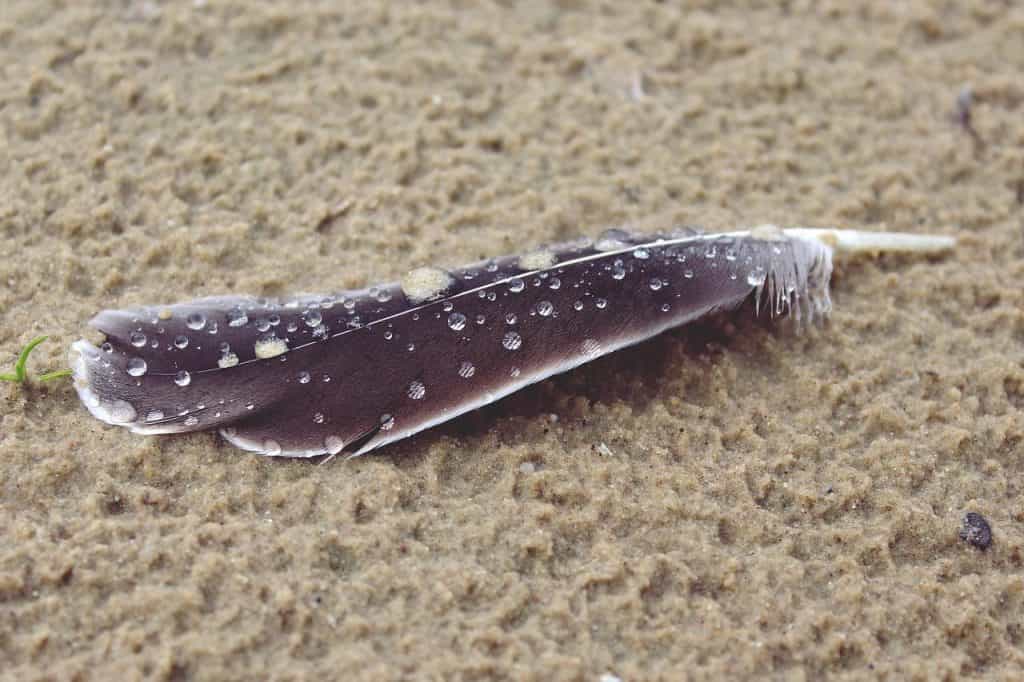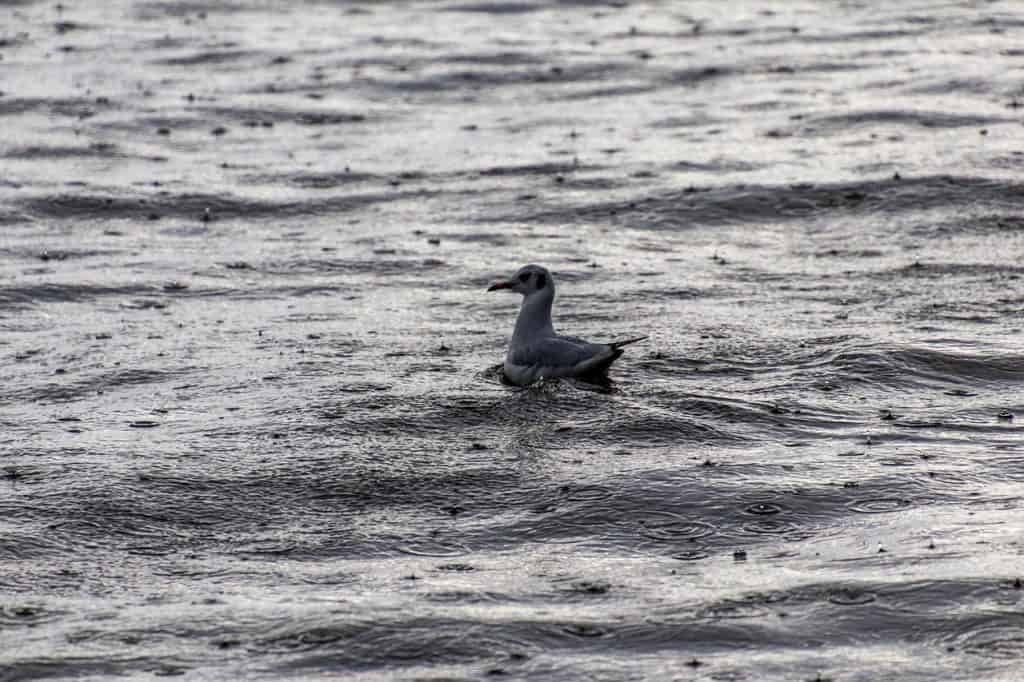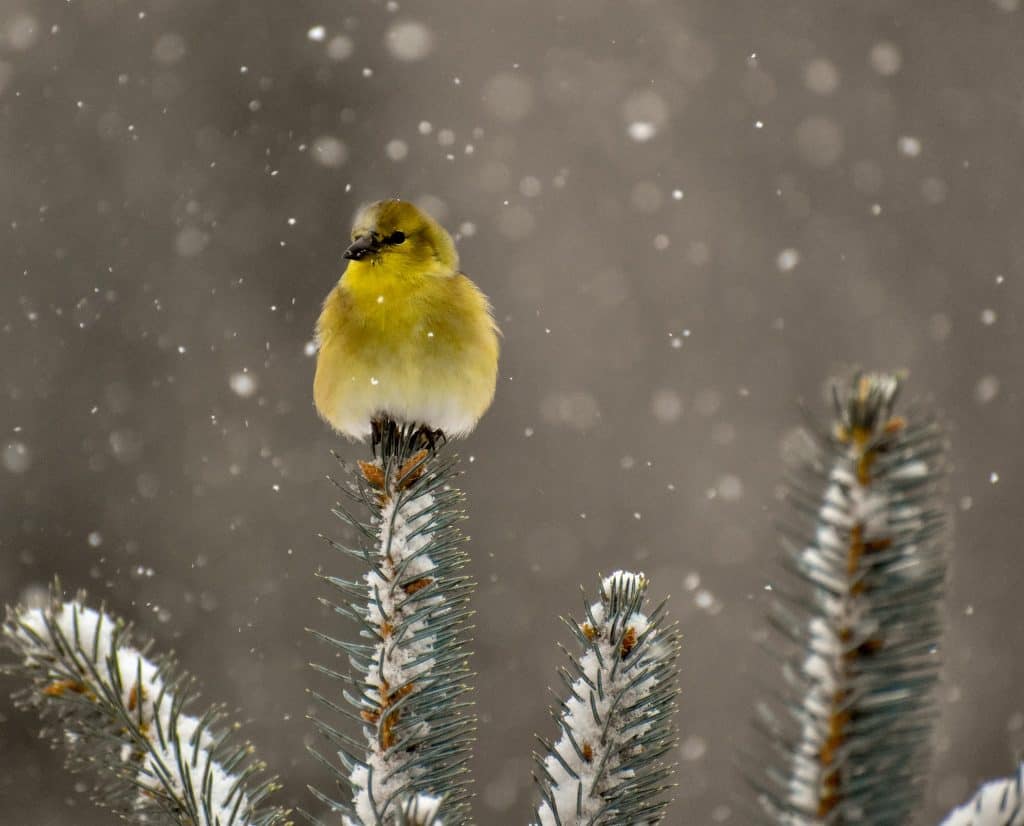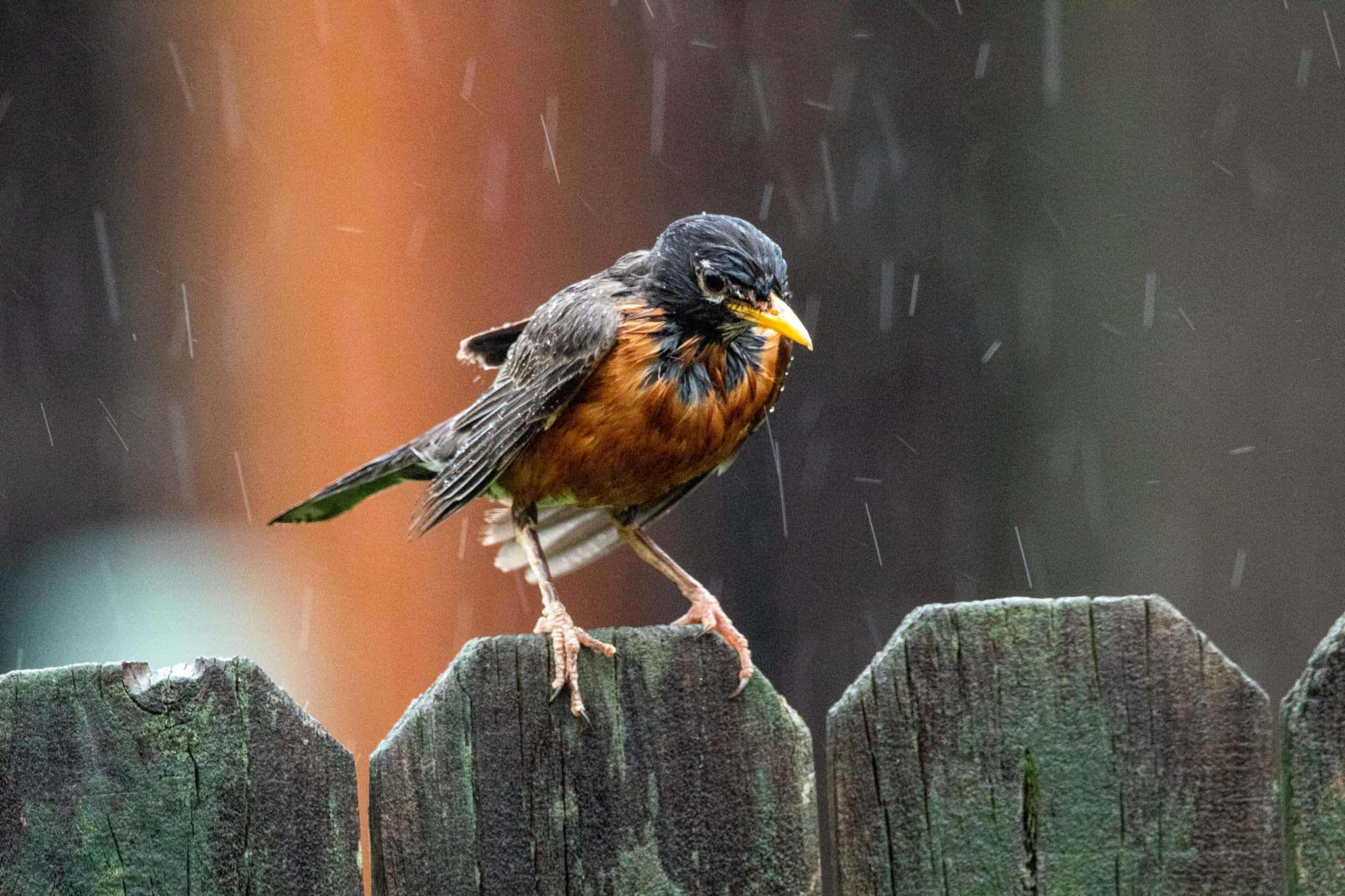Inside: Many of us wonder where birds go when it rains. They seem to disappear, but where do they go?
Storm clouds start rolling in, the skies turn dark, and humans look for shelter. We seek safety from the storm as a natural response. But what about birds? Birds live outside in Mother Nature, exposed to the elements. So what happens to birds when it rains? Where do they go for shelter during stormy weather?
I’ve been backyard birding for more than 20 years and often noticed there are no birds around when it’s raining. I finally decided to dive into the evidence and discover why that is.
Typically when threatening weather is within proximity, birds seek shelter. They can sense the air changing and have fight-or-flight instincts to find a safe place until the storm passes. However, different types of weather impact birds differently based on their species, climate, and geographic location.
Rainy Days

Birds of all kinds can adapt to weather changes because of their genetic makeup. Bird feathers repel water. Because of their innate instincts, they flatten their feathers more as the rain grows heavier. These two traits allow birds to bounce back more quickly after storms because their feathers hold little to no rainwater.
Due to their ability to repel water, most birds will remain busy during light rain. They continue building nests, searching for food, and going about their day. It is not until heavy rain, excessive wind, or snowstorms appear that birds begin to seek immediate shelter.
The severity of a storm’s threat to a bird also depends on the species and other external factors. Birds that survive extreme weather conditions have three things in common: adaptability, location, and preparation.
Land Birds
Land Birds, for example, are unique because their feathers shed rain and water. Their feathers also trap air against their bodies which they use to keep warm. They can usually withstand light rain and don’t have to seek immediate shelter due to their ability to shed the rainwater and insulate heat.
However, when heavy rains arrive, land birds will seek shelter in nearby bushes and trees, where they remain motionless to preserve energy.
Land birds need to find appropriate shelter if a storm lasts for days on end because any prolonged rain storm can cause them to run an energy deficit. It is extremely crucial to their survival.
Similarly, birds store energy during the night by remaining motionless and they react the same during this weather. Without conserved energy, these birds become weak, inevitably making them a target to their prey.
Cavity-nesting Birds
Cavity-nesting birds are a little bit different from land birds when it comes to rainy days and bad weather. When it rains, cavity-nesting birds such as bluebirds, owls, woodpeckers, and chickadees, often hunker down in their nesting boxes and wait out the storm.
I captured the video below of a sweet bluebird momma hunkered down in her nesting box during a rainstorm.
These birds normally make their nests in old trees, or trees with many character defects. Other times, human activity creates nesting spots for birds, like sheds, barns, birdhouses, etc.
While all birds nest and lay eggs, cavity-nesting birds don’t create their nests from raw materials in nature. Their nests are more like hidden cavities in rocks, trees, dirt mounds, and other chamber-like dwellings. Due to this, they can adapt quickly when a storm threatens their nest.
Waterbirds and Aquatic Birds

Waterbirds and aquatic birds are more used to being wet than other species. Ducks, geese, herons, sandpipers, and other shorebirds will typically stay out in the rain. These birds normally seek shelter when conditions become extreme. These waterbirds find dense bush areas and structures as a means of shelter.
Ecosystems, Climates, and Migration
While it’s true that most birds migrate, not all birds do. Scientists and studies have shown that approximately 75% of birds migrate. Their reasons for migration can vary due to weather, lack of food sources, or lack of sustainability in any particular climate.
Florida for example has many waterbirds and tons of other beautiful birds. But Florida is also a heavy rain state in the Summer months. This ecosystem and climate are conducive to waterbirds and shorebirds. The rain does not normally affect the migration path of these birds.
In midwestern states like Indiana, however, we see snow and wind with various types of winter storms. Birds in these areas migrate South during this time of year. Despite the different climate and ecosystem, Indiana is still home to over 300 bird species annually which makes it a beautiful place for bird watching!
There are four main groups of birds when it comes to migration: permanent residents (non-migratory birds), short-distance migrants, medium-distance, and long-distance. Most birds are climate and food-driven for survival.
Permanent resident birds do not migrate at all. They have made permanent homes and can withstand whatever weather conditions are active in that climate or region year-round. Their food sources remain stable and thus, they do not feel threatened by various weather conditions and storms.
Short-distance migrants stay put in a particular climate but make little changes to their life by migrating within proximity. They may migrate to different elevations, but stay relatively close. They are not affected by weather and migrate when food sources are low instead of migrating due to snow, rain, or wind.
Medium-distance migrants can travel any distance that spans approximately a few hundred miles. Geese, for example, migrate South when weather conditions and storms become too frequent that their food supply runs dry.
Long-distance migrants travel most of their lives. These are birds that may leave Canada or the United States and fly south to Central and South America. While the distance is far greater and the trip is far more dangerous, approximately 350 North American birds follow this flight path each year. These are the species of birds most affected by the weather in a particular climate.
Overnight Storms, Wind, and Snow
Except for nocturnal birds like owls, many birds take their rest at sundown. Birdwatchers know this firsthand. Birds leave their nests in the morning and spend the day foraging and fly home before sundown.
Birds treat overnight storms the same as most daytime storms. If they aren’t tucked away in a nesting cavity, they remain still in thick shrubbery or trees.
Birds can still fly when it’s windy out, however, most will find a spot to land if the wind is too strong.
Birds lose heat naturally as humans do. However, birds are in greater danger of freezing when out in the elements due to their size and exposure. Birds that can regulate their body temperature to mirror their environmental temperatures have a lower rate of heat loss. Birds can puff up and trap heat with their feathers which aids in retaining heat energy.

Birds typically conserve heat and energy during snow storms the same way they do during overnights when temperature levels drop. Cold-climate birds pack on body weight during the Summer and Fall months to prepare for the arrival of the snow.
Most birds do not have feathers on their feet and legs, which is how birds keep from freezing and dying in the snow. Their feet act as temperature regulators and mirror the temperature of whatever their feet touch. Their little feet keep them alive. This process is called a counter-current exchange.
The National Audubon Society maps bird migration flight paths and maps their habitats. They have scientists and bird experts track how long species of birds can last in certain weather climates.
Conclusion
Birdwatchers and admirers enjoy taking photographs before and after the rain because birds are active during this time. If you live along a migrational path or have permanent species in your area, take a peek outside the next time it rains and watch how the birds adapt for yourself!



